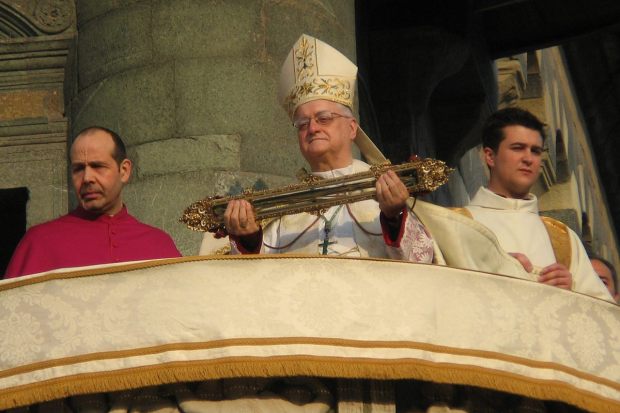It is known as the Girdle of Thomas, the Virgin’s Girdle, or the Holy Belt, and is considered the Catholic equivalent of other Orthodox Christian relics --namely, the Eastern Orthodox Cincture of the Theotokos or the Holy Girdle of the Syriac Orthodox Church.
Relatively unknown outside of Italy, the Sacra Cintola (Italian for “holy belt”) is the Virgin Mary’s own belt. According to medieval traditions and legends, she dropped it at the time of her Assumption.
But if the relic is actually the Virgin’s belt, why is it popularly known as the Girdle of Thomas?

One of the reasons is that the legend most likely originated in the East, probably not far from where tradition maintains Thomas himself preached the Gospel. But even if Thomas’ mission in India is certainly famous —he is considered the founder of the Indian Nasrani (“Nazarene,” Christian) church — he is better known for being the doubting apostle. The episode is told in detail in chapter 20 of the Gospel of John. The text reads:
The story of the girdle is relatively similar. It is included in Jacobus de Varagine’s The Golden Legend and in the medieval York Mystery Plays. One version claims that all the apostles were present during the Assumption of Mary —all but Thomas, who was rushing back from India. Aware of Thomas’ skepticism, the Virgin appeared to him alone, and dropped the girdle she was wearing down onto him, as if mimicking Jesus’ gesture of providing the doubting apostle with physical proof of the miraculous feat that he had just witnessed.
Another version claims Thomas was miraculously transported from India to the Mount of Olives so that he could be present during the Assumption, and the Virgin dropped her cintola down to him, as she was being taken up to heaven. And yet another account claims that it was only Thomas who actually witnessed the Assumption, and the Virgin left the belt as a proof for his story to the other apostles. This final version is clearly an inversion of the “doubting Thomas” episode of the Gospel.
The Catholic relic has been preserved for at least seven centuries in the Prato Cathedral, in Italy. From the 14th century on, the story was frequently depicted in proto-Renaissance and Renaissance Tuscan art —including works by Fra Filippo Lippi, Raphael, Tiziano, and Pinturicchio. Botticelli’s version is sadly lost, and only preserved in a sketch. The veneration of this relic is regarded as especially helpful for pregnant women.

